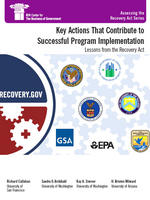
Recovering from the Recovery Act - Part 4

What happened?
While there are debates as to whether the Recovery Act saved the economy or not, the one thing that has not been in the headlines was the way federal agency leaders implemented more than 200 programs that were used to distribute the money.
A new IBM Center report, Key Actions That Contribute to Successful Program Implementation: Lessons from the Recovery Act, by Richard Callahan, Sandra Archibald, Kay Sterner, and Brinton Milward, explores what happened on the frontline of nine of more than 200 programs created or given increased funding under the American Recovery and Reinvestment Act of 2009 (Recovery Act).
Background. The Recovery Act, signed less than a month after President Obama took office, mandated that agencies quickly commit more than $787 billion in tax benefits; grants, loans, and contracts; and entitlements. Historically, spending under stimulus legislation tended to peak after a recession was over, oftentimes creating inflation instead of jobs. To avoid this, the Recovery Act mandated tight timeframes, with 70 percent of the money required to be spent within 17 months to generate jobs. There was significant concern that this rapid spending might result in an estimated $50 billion in waste, fraud, or abuse. Accordingly, there were stringent transparency and accountability requirements embedded in the law.
The scale of spending – equivalent to almost an additional year of spending on top of regular spending – and the stringent spending requirements posed significant implementation challenges to federal executives. How did federal executives respond?
Common Challenges. Based on interviews and case studies with federal managers, the authors identified four common challenges they faced in implementing their programs under the Recovery Act:
- Having to meet new accountability requirements and develop cross-agency governance mechanisms in real-time.
- For existing programs, having to manage huge spikes in spending, sometimes equivalent to 4 or 5 times a “normal” year’s spending.
- For new programs, having to develop the rules, guidelines, and training for thousands of recipients in weeks, not months.
- Having to navigate or redesign traditional administrative processes – contracting, oversight, regulatory compliance -- that may be too slow to meet the statutory deadlines in the Recovery Act.
The authors found that federal executives created new models for program design, innovated new implementation procedures, and developed new ways of engaging stakeholders and funding recipients. For example, the Department of the Treasury was tasked with implementing two new programs to provide capital for low-income housing and renewable energy generation projects. Both programs provided cash payments in lieu of pre-existing tax credits. The housing program chose to use existing state agencies to deliver its new program while the energy program turned to a Department of Energy lab to help it deliver its new program. Both programs were operational in weeks instead of the more typical multi-month approach when implementing more traditional programs.
Common Implementation Actions. The authors also identified a set of common actions taken by these federal executives to meet the Recovery Act’s requirements that could be applied in the future by those facing similar challenges to achieve large-scale results under tight deadlines.
- Set deadlines to create a sense of urgency. Statutory deadlines focused attention, but self-imposed interim deadlines maintained momentum.
- Create dedicated project teams. Most agencies created temporary, full-time project management offices where dedicated executives drove implementation.
- Use technology to track progress. Off-the-shelf technology provided program managers real-time data which had never been available before.
- Streamline grant and contract processes. Anticipate bottlenecks and streamline processes in advance of implementation.
- Build in transparency and accountability. The law’s significant accountability requirements were largely met with web-enabled approaches.
- Identify risk and manage them. The transparency tools made it possible to move from traditional fraud recovery techniques to fraud prevention.
- Foster real-time learning. Cross-program real-time conversations among senior managers allowed sharing experiences and learning.
- Create horizontal networks. Cross-agency networks at the program level allowed lessons to be shared, but also greater front-line coordination.
- Embrace adaptation as a mindset. Since few political appointees were in place at the time the Act was passed, career executives were encouraged to innovate and improvise in order to meet goals.
* * * * * * * * *
Related Posts on Recovery Act Implementation. This report is one of a series examining the implementation of the Recovery Act. Following are related blog posts:
Part 1: Recovering from the Recovery Act: The Story from the Bottom: Cities’ Experiences
Part 2: Recovering from the Recovery Act: The Story from the Top: The Recovery Implementation Office
Part 5: Recovering from the Recovery Act: How States Reported on Use of Funds



